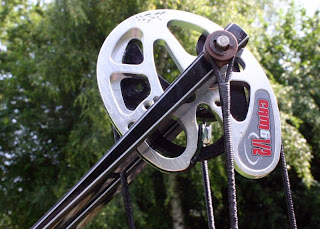Turkey’s world-class archers aim at medals in Summer Olympic Games
Archery is one of the oldest sports in the world. You can see mythological figures such as Apollo or Eros carrying bows and arrows. If we must stay within the borders of Turkish history, we can see that the sport was practiced in early Turkish states, but the greatest importance was attached to it during Ottoman times.
Fatih Sultan Mehmet, the conqueror of İstanbul, concentrated archery activities and the production of bows and arrows in İstanbul's Okmeydanı (Square of Arrows) district. Subsequent sultans expanded the district by adding additional facilities. Later, a bazaar was opened behind Beyazıt Mosque in İstanbul where all the manufacturers of archery equipment gathered. Although the sport went into decline during the later periods of the Ottoman Empire and during the early years of the Turkish Republic, numerous attempts have been made to revive the tradition of Turkish archery.
Turkey became the 16th member of the International Archery Federation (FITA) in 1955. After the establishment of a national archery federation in 1961, Turkish archers began to represent the country at an international level. There was an interruption in the development of the sport in 1982, when the federation was attached to the Turkish Shooting and Hunting Federation. The Turkish Archery Federation was re-established in 1982, and Uğur Erdener became the head of the federation. Erdener would later manage archery throughout the world when he was elected president of FITA in 2005.
After being honored by Erdener's election as the new president of FITA, Turkish archery has turned its focus to earning medals in the upcoming 2012 Olympic Games in London. “We, as the Turkish Archery Federation, aim to be more successful. We are distinguished among other archery federations in that our former president is now the president of FITA. We are very proud of this. Now, we want to win medals at the Olympic games. Our best Olympic score was fourth place in the 2000 Sydney Olympics. We were very close to winning a medal, but we did not,” Turkish Archery Federation President Abdullah Topaloğlu, who has a 32-year history in the sports world in Turkey and has served in numerous posts of various federations, told Sunday's Zaman.
‘Archery is an expensive sport'
Even though archery has a significant place in Turkish history, there are not many archers in the country today -- there are around 7,000 registered archers in the federation -- because the sport is expensive, said Topaloğlu, noting that they are working to develop archery in the country. “We have around 270 trainers who were brought up in the federation's courses. But we cannot use them efficiently. Only 70 or 80 of them are actively working,” he said. Apart from financial obstacles, Turkey also suffers from a lack of archery facilities. Because the sport has few practitioners, those who do practice archery do not have many facilities to choose from. “We have a facility in Antalya, and archers can practice there for the entire day. We plan to establish such facilities in Ankara and İzmir, too. We work in cooperation with the metropolitan municipalities of some provinces where there is the potential for practicing archery. Other federations cooperate with the Education Ministry, but we cannot spread the sport to all schools since TL 1,000 to 1,500 is needed for each student of archery. For such reasons, we approach the development and expansion of the sport regionally in Turkey,” Topaloğlu elaborated.
The federation's president further said the interest of Turkish people in archery is gradually rising due to the international archery competitions held in Turkey, especially after the TV broadcasts of the World Archery Cup, which took place earlier this month in the southern province of Antalya. “We received a lot of calls asking for information about the courses offered by the federation. We are trying to meet the demand. Also, around 350 children applied to the Juniors Cup -- which started yesterday and ends today. We are witnessing such a large number of applications for an archery competition for the first time. It is promising. They are the future archers,” Topaloğlu said.
Turkish archer survives after arrow enters his head
An interesting incident occurred in Turkey in 2004. Archery enthusiast Hakan Budak accidently shot his friend, Cem Balcı, in the head while they were practicing the sport as a hobby. Balcı underwent an operation and was unconscious for 11 days, but he survived. Stating that he was at fault for the accident, Balcı told the Anatolia news agency: “Such an accident has occurred three times in the world so far. If I had obeyed the rules, the arrow would not have struck my head.” He also stressed that the sport is safe and that no one should be afraid to practice it.
Topaloğlu agrees with Balcı about the safety of the sport. “Those who open an archery facility must have a trainer's certificate, and safety precautions must be taken in the field. Such an accident had never happened before in Turkey. It is not about the nature of the sport, which is normally harmless. The accident occurred solely due to a personal mistake,” he explained.
21 June 2009, Sunday - ESRA MADEN - İSTANBUL- Source : http://www.todayszaman.com/tz-web/detaylar.do?load=detay&link=178621&bolum=127




















